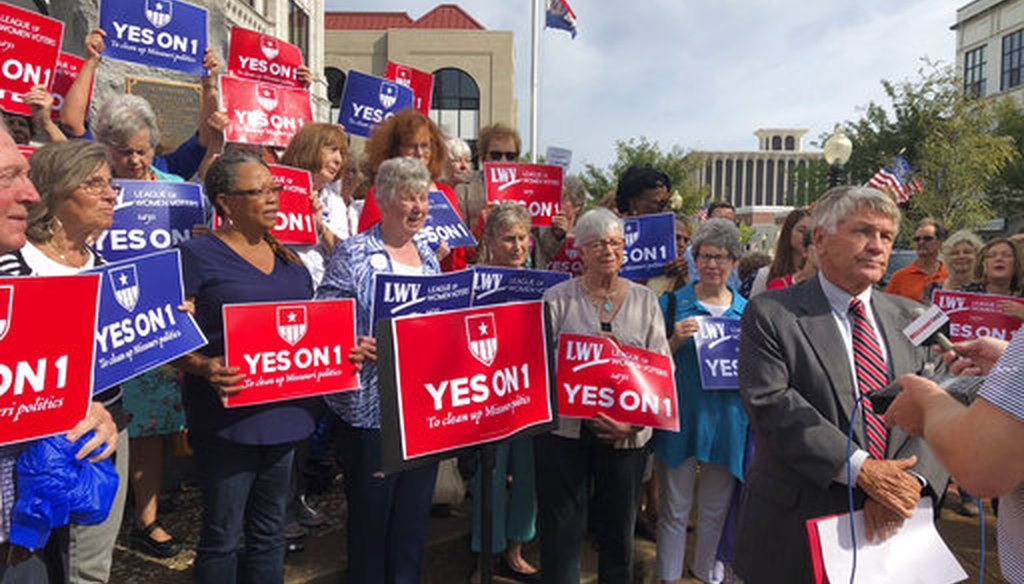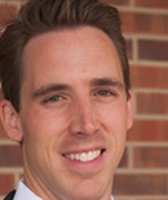Get PolitiFact in your inbox.

Supporters of a 2018 redistricting ballot measure in Missouri gathered in Jefferson City, Mo. (AP)
If Your Time is short
-
Republican leaders have said that Amendment 3 could be interpreted to not count children or non-citizens for redistricting.
-
Legal experts say this has never been done before, but there are no laws preventing it from happening.
-
The words “one person, one vote” do not necessarily mean that only adults will be counted for redistricting.
Amendment 3 is a hot topic on Missouri’s ballot this year. If approved, the amendment would overturn the Clean Missouri amendment that was passed in 2018. At stake are drastic changes in the way the state draws political districts.
Democratic House candidate Tracy Grundy ran a Facebook ad against the measure from Sept. 24-29. Grundy is running for House District 102, which includes Weldon Spring and O’Fallon.
The ad claimed that Amendment 3 "for the first time ever, would not count children in population for redistricting." It was seen by between 100,000 and 500,000 people on Facebook.
Grundy says she got her information from cleanmissouri.org, which claims Missouri would be the first and only state to disallow children in the redistricting count if Amendment 3 is passed. Other anti-Amendment 3 groups have made similar claims, and it has become a talking point for opponents.
There are about 1.5 million children in Missouri.
We found that, ultimately, Amendment 3 could allow the exclusion of children, but trying to do so might not work. With too many "ifs" and future possibilities, we decided not to rate the claim on the Truth-O-Meter. But we looked into the details to explain the issue.
One person, one vote
Redistricting occurs every 10 years after the Census calculates the number of people living in each current district. The proposed amendment doesn’t affect the Census count — just what portions of the census are used for redistricting.
Traditionally, the party in power gets to pick the districts and does so in ways to help it win future elections. That’s called gerrymandering. The 2018 amendment upended the process by calling for a nonpartisan state demographer and changes to the criteria for drawing the map.
The amendment this year would undo those 2018 provisions.
Where do children come into play? Here’s the actual language of the amendment: "Districts shall be as nearly equal as practicable in population and shall be drawn on the basis of one person, one vote."
Sean Soendker Nicholson of the Clean Missouri campaign says Republicans are interpreting that to mean only adults are counted for redistricting. The bill’s sponsor, Republican Sen. Dan Hegeman, denies it.
In a Senate debate on Jan. 29, Hegeman responded to a question about the wording of "one person, one vote." He said: "The people that are able to vote are the people that are counted."
This sounds like only citizens age 18 and up will be counted. In an email, though, Hegeman said this is not the case.
"Nothing in Amendment 3 prohibits the counting of children. Instead, it mandates that the principle of one person, one vote, should apply," Hegeman said. "The question then becomes which ‘population’ must be equal. Is it the population of those who can actually vote, or every person who can be found in a district? That choice is left to the General Assembly."
Hegeman says that if passed, children would be excluded from the redistricting count only if the General Assembly chose to interpret the law as eligible voters.
Total population
This whole debate comes from the changing of one phrase. The Clean Missouri amendment of 2018 changed "one person, one vote" to "total population." In Amendment 3, "total population" would be changed back to "one person, one vote" again.
"The opponents claim that the rewriting of the language, with the removal of ‘total population,’ would remove children from being counted," Hegeman said. "Which is untrue, because removing ‘total population’ just goes back to what we had before, where children were always counted."
According to a written testimony from the Brennan Center for Justice to the Missouri House of Representatives General Laws Committee on April 30, what Hegeman is saying is plausible.
This is because of precedents set by the U.S. Supreme Court and Missouri’s history with redistricting. Missouri has done redistricting based on total population, just like every other state, for more than 150 years, according to the testimony. It was written by Nimrod Chapel Jr. of the Missouri NAACP and Yurij Rudensky and Ethan Herenstein of the Brennan Center for Justice.
The testimony goes on to say, "In 2016, the Supreme Court unanimously held in Evenwel v. Abbott that districts drawn on the basis of total population satisfy the "One Person, One Vote" principle."
Is it likely?
Yurij Rudensky is a legal expert on the Redistricting Council with the Democracy Program at the Brennan Center for Justice. Rudensky says while there is evidence to show that Republicans want to leave out children and non-citizens, there is a possibility that it might not happen.
Rudensky referred to the people who sponsored Amendment 3 as well as Missouri Solicitor General John Sauer. In an oral argument on Aug. 28, Sauer explained his understanding of the amendment to a Circuit Court judge.
"So 'one person, one vote', the criteria is based on the number of actual eligible voters in a relevant district, as opposed to an absolute population," Sauer said.
Just because some Republicans want it to be interpreted that way doesn’t mean it has to be.
"You can use total population. That is clearly constitutional for a state to draw districts that are based on total population," Rudensky said. "The open question is whether that is mandatory."
If passed, the General Assembly could choose how to interpret the language. According to a report from the Brennan Center, not counting children or non-citizens would disproportionately affect communities of color.
"Only 21% of Missouri’s white population would go uncounted," Rudensky writes. "By contrast, 28% of Missouri’s Black population, 54% of its Asian population, and 54% of its Latino population would be erased when district lines are drawn."
This would lead to an advantage for Republicans, as more older, white citizens would be represented.
Our Sources
Interview, Drew Dampf, spokesperson for Mo. Senator Dan Hegeman, Oct. 1
Interview, Sean Soendker Nicholson, spokesperson for Clean Missouri, Oct. 2
Interview, Yurij Rudensky, Redistricting Council with the Democracy Program at the Brennan Center for Justice, Oct. 5
Facebook, Tracy Grundy’s Ad, Sept. 27
Cleanmissouri.org, ‘Dirty Missouri’, Sept. 29
Cleanmissouri.org, Full Amendment Text, Sept. 29
Brennan Law Center, Amendment 3 Testimony, Sept 30
Brennan Law Center, Gerrymandering Away Missouri’s Future, Oct. 2
Oyez.org, Evenwel v. Abbott, Oct. 3
Commoncause.org, Hofeller Study, Oct. 3
Missouri Courts, Oral Argument, Oct. 6
Clean Missouri Youtube Playlist, Hegeman and Sauer Statements, Oct. 2
Missouri Census Data Center, Population Analytics, Oct. 12






























